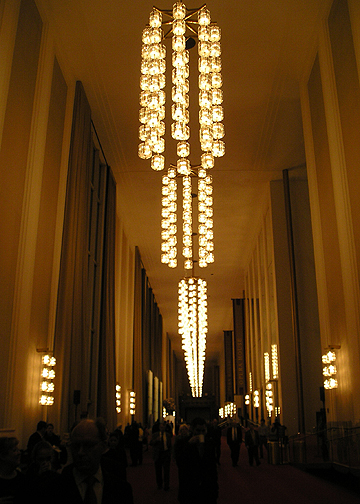
Saturday, February 17, 2007
Friday, February 9, 2007
All Mendelssohn, all the time
 Last night the National Symphony Orchestra premiered a three-performance run of an all Mendelssohn concert in the Concert Hall of the John F. Kennedy Center for the Performing Arts under the baton of Iván Fischer, NSO's principal guest conductor. This marks the premiere of Mendelssohn's Symphony No. 1 in C minor, Op. 11, to the NSO repertory.
Last night the National Symphony Orchestra premiered a three-performance run of an all Mendelssohn concert in the Concert Hall of the John F. Kennedy Center for the Performing Arts under the baton of Iván Fischer, NSO's principal guest conductor. This marks the premiere of Mendelssohn's Symphony No. 1 in C minor, Op. 11, to the NSO repertory.The orchestra was arranged rather differently for this perfomance. The double bass section was spread out all the way across the back of the stage. The cello section was in the very middle, in front of the conductor. Second violins were on the right, with violas between them and the celli. This arrangement actually worked very nicely, as it gave us a nice stereophony during many of the musical passages that had almost a "call and answer" feel between the first and second violins. We especially felt that, as our four seats were fifth row center.
The concert opened with the First Symphony. I was surprised to note that this was the first time NSO had done this fine work, although it is, for some reason, not one of the more frequently performed Mendelssohn pieces. The first and fourth movements are particularly spritely and furious, and Maestro Fischer had a better workout than an hour of kickboxing. The way he danced around and flailed his arms, then trembled and shook, it was as if he were having an epileptic seizure. From our position, it was easy to see his conducting pattern, and I would not have liked performing for him, as I've always found that type of conducting extremely difficult to follow. The NSO, however, had no problems with him, and they played vivaciously throughout.
The symphony was well received, and the audience awarded it with three curtain calls (which was better than the second half, which only got two).
After intermission, they played the incidental music for A Midsummer Night's Dream, Opp. 21 and 61. This work, especially the overture, contains a lot of commonly familiar melodies, especially to those who occasionally listen to classical radio stations. For the "Song with Chorus," NSO was joined by the ladies of the University of Maryland Concert Choir who, rather than being on risers in the back of the orchestra as usually happens with choruses, were interspersed amongst the orchestra players and stood during those passages when they were to sing.
Featured with the choir were soprano soloists Carolyn Betty and Judith Norton. Miss Betty had a full, beautiful, operatic voice that had great presence and easily was heard over the orchestra and chorus. She chose to wear a black velvet top over a long, black silk skirt, all covered with a large black shawl with a windowpane pattern texturally woven into the fabric. Miss Norton was a last-minute substitute for the originally scheduled Kelley O'Connor, who was ill. Miss Norton is a featured soloist from the United States Army Soldiers' Chorus, and she didn't show up in uniform; she wore a strapless black charmeuse silk gown that accentuated her lovely, milk-white shoulders. I'm not sure how much notice she had to fill in for this performance, since the cast change appeared only on a sign outside the entry and there was no insert or biography in the program. She had a pleasant voice, but she lacked the power of a trained opera singer and even on the fifth row I had to pay particular attention to be able to hear her unamplified voice clearly.
One of Mendelssohn's best known melodies happens near the end of the incidental music, the "Wedding March" that has been a popular bridal recessional march since it was used at the royal wedding of George V of England in 1893. I'm used to hearing the organ transcription of the march, so it was fun to once again hear the original, fully-orchestrated version. The trumpets were particularly bright for the fanfares. There are also a few passages accented with multiple crashes of the cymbals, and, while it may have been a factor of sitting so close to the stage, I thought they were really rather way, way too loud. Otherwise, it was a fun piece, and I was amused to see all the happy smiles on the faces of audience members as the tune was played.
Twas a short concert—we were out at about 8:45—but a quite enjoyable evening. Performances continue tonight and tomorrow night.
Monday, February 5, 2007
The blandness of over creativity
This afternoon I watched all the television commercials from last night. Does anyone else share my impression that those ad agencies are trying just a little too hard to be quirky?
Subscribe to:
Posts (Atom)
